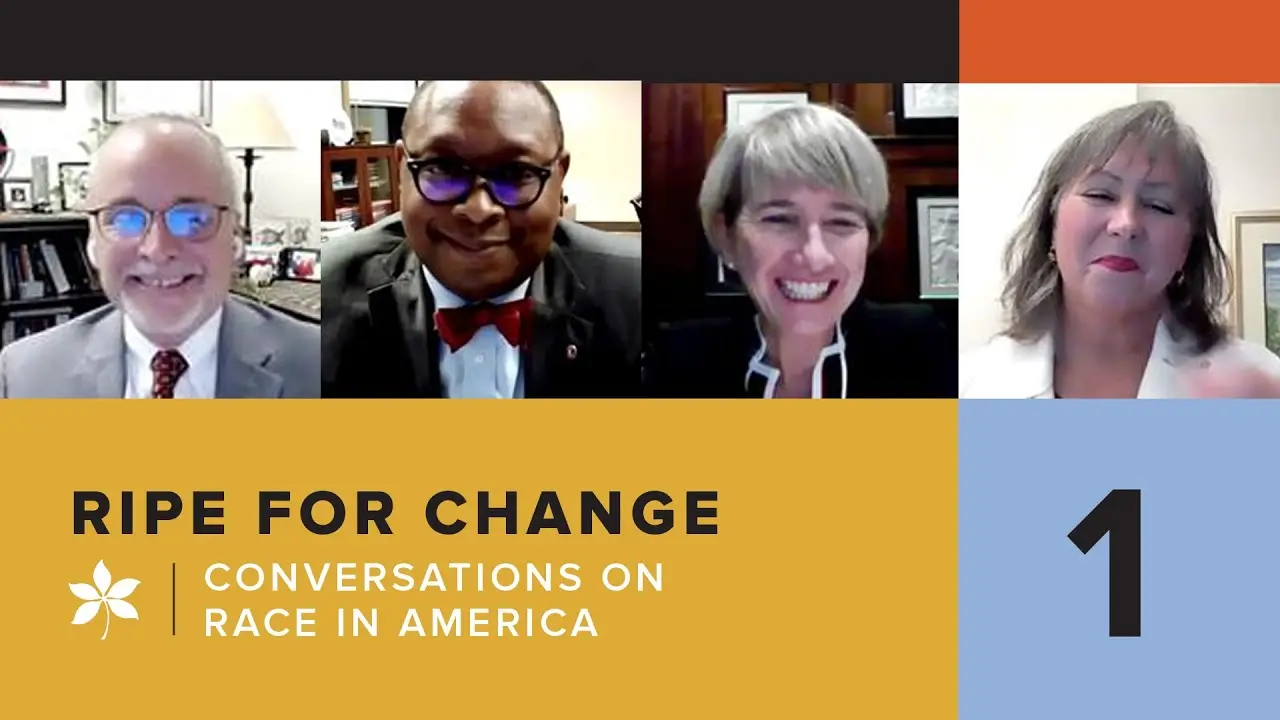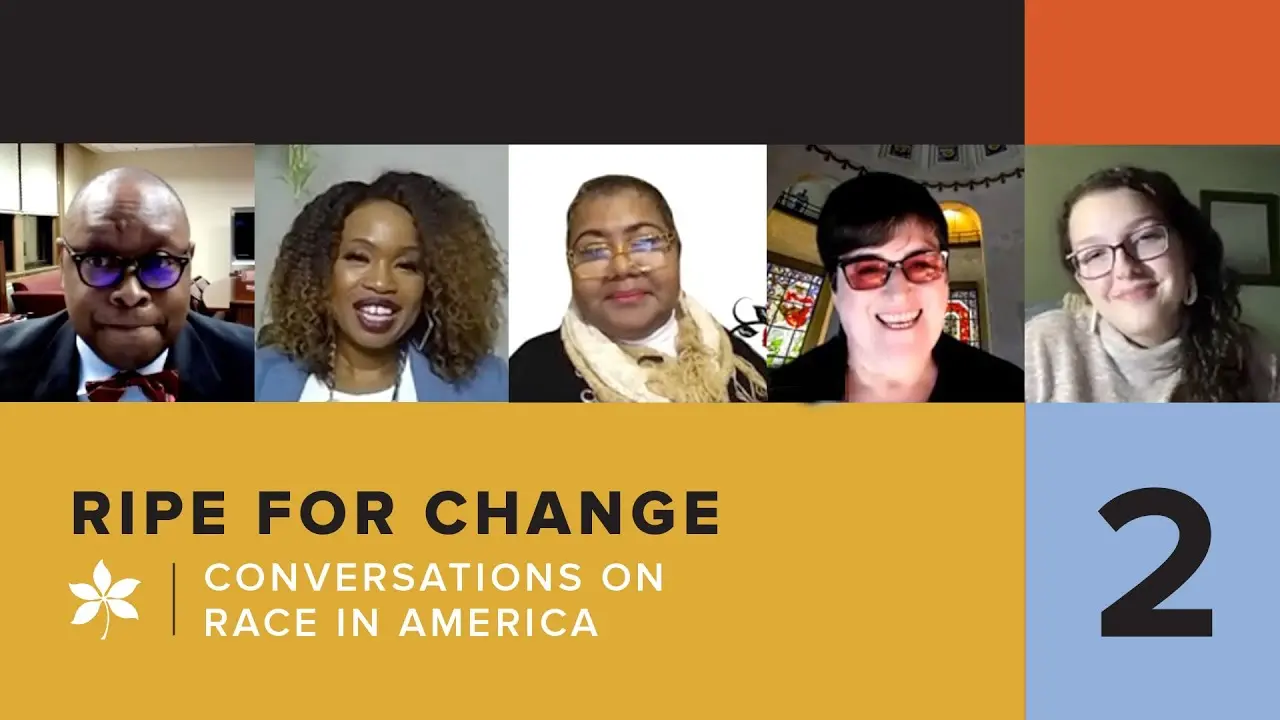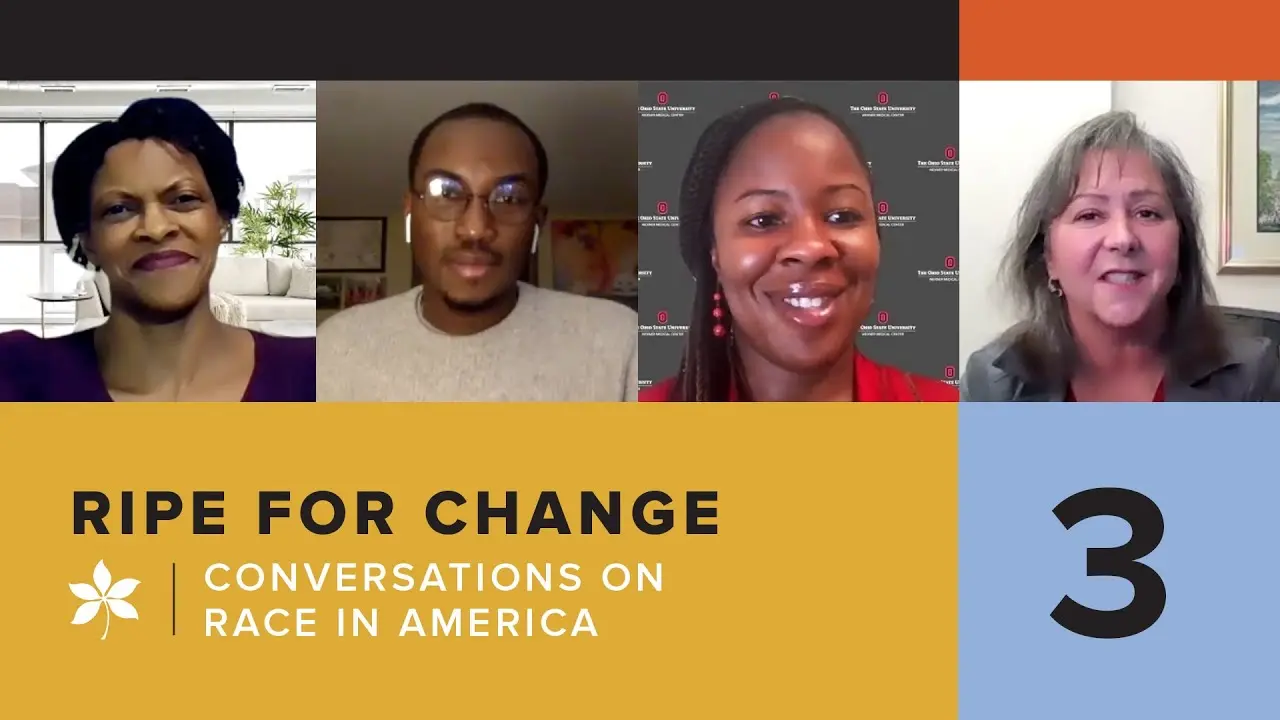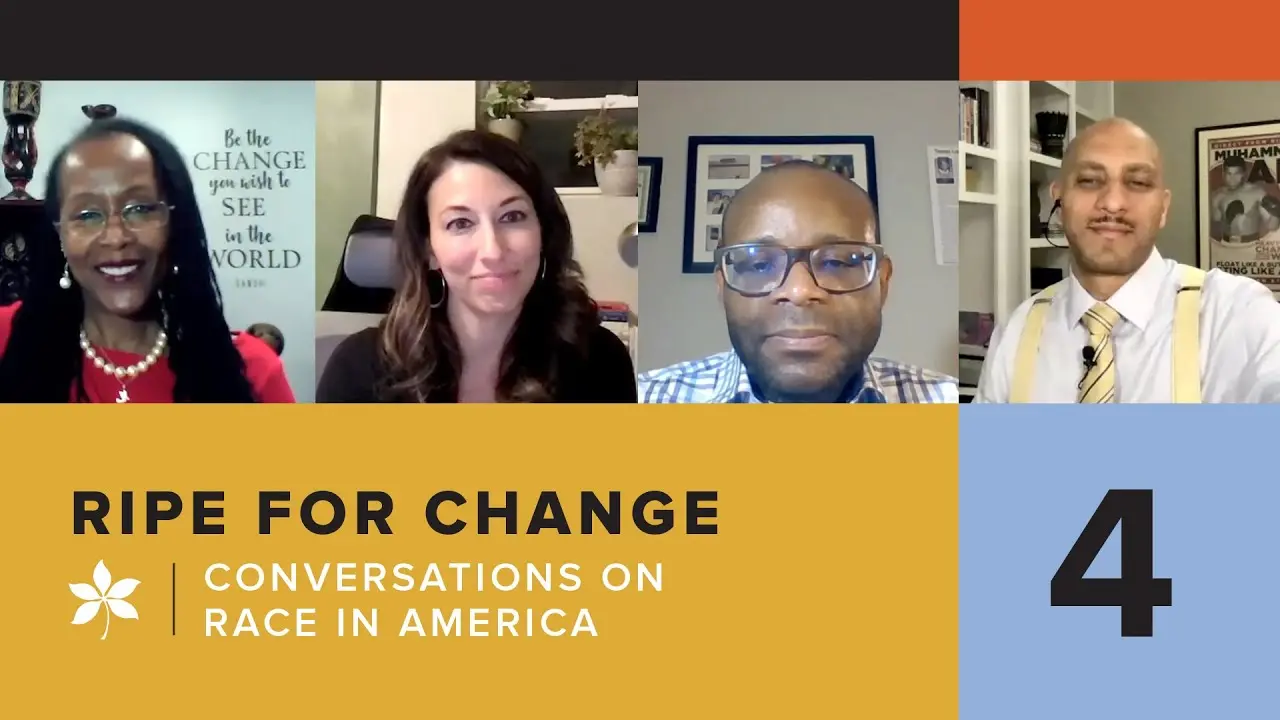Ripe for Change: Conversations about Race in America
A four-part series of online discussions explores how race and surrounding issues challenge our community. Listen in.

Adrian Franks / Pat Kastner
Part 1: Confronting inequity on our home front
This month and next, Ohio State alumni, faculty, students and leaders are participating in a series of online discussions on the theme Ripe for Change: Conversations About Race in America. The series is propelled in part by Ohio State Alumni Magazine’s stories about what Buckeyes are doing to make a more just and equitable world, and will feature sources from several of the stories.
The series kicked off the evening of Oct. 20, when Ohio State President Kristina M. Johnson, Vice Provost for Diversity and Inclusion James L. Moore III and College of Social Work Dean Tom Gregoire discussed creating an “actively anti-racist” university with alumni association President and CEO Molly Ranz Calhoun, who served as moderator.
We’ve posted the full conversation in the YouTube video below.
A few highlights of the conversation:
- Johnson said Ohio State’s student body should better reflect the population of Ohio, which is about 14% African American. According to the university’s 2020 enrollment report, 7.38% of students are Black. She also expressed a desire to grow diversity within the faculty, which is about 4% African American. To increase diversity, she pledged to hike recruitment of underrepresented minorities and expand scholarship opportunities in Ohio’s big cities. Johnson also said she looks forward to receiving the recommendations of a Buckeye task force studying ways to make Ohio State a more diverse, equitable and inclusive university. She said she is focusing on “the art of the possible” and encouraging university leadership to “think really big and really bold and see what it would take to move the needle.”
- Moore and Gregoire, who co-chair the university Task Force on Racism and Racial Inequities, encouraged alumni and others to have the “uncomfortable conversations” around racial justice. “There can be no bystanders in this work,” Gregoire said. “The status quo is harmful to many people.”
- A self-identified “son of the South” from South Carolina, Moore said the university’s size and reach create a rare opportunity to help lead sweeping societal changes. “I think this is one of the grand challenges — how do we solve some of the social, racial challenges?” Moore said. “I think Ohio State is poised to play a critical role not only in Columbus, Ohio, but in the entire country.”

Part 1 focuses on creating an “actively anti-racist” university. Run time: 56 minutes
Part 2: Disparities highlight our need to do better
At the Oct. 28 roundtable, Columbus City Councilwoman Shayla Favor ’03; Rachel Garshick Kleit, associate dean for faculty affairs and a professor of city and regional planning in the College of Engineering; Donna Ford, distinguished professor in the College of Education and Human Ecology; and art education major Morgan McDonald discussed housing, education and other issues affecting Central Ohio with Vice Provost for Diversity and Inclusion James L. Moore III, who served as moderator.
We’ve posted the full conversation in the YouTube video below.
A few highlights of the Oct. 28 conversation:
- Favor, head of council’s housing committee, spoke about the impact of housing insecurity on people of color, seniors, women and low-income wage earners. She described Columbus as being in a housing crisis, with 17,000 evictions a year and far too few units being added annually to meet projected demand. “There’s no silver bullet that will end our housing crisis, but a shift in the system often leads to a shift in outcomes,” she said.
- An expert on affordable housing, Kleit explained that the residential pattern in Columbus and elsewhere in the United States has been shaped by unequal access to mortgage loans and overtly racist practices such as “redlining.” “It’s a result of some people having more opportunities and more choices than others,” she said. Kleit called for more creative housing programs like Move to Prosper, a housing mobility pilot program involving Ohio State and other partners.
- Ford, a scholar on gifted education and multicultural education, said Black students are sorely underrepresented in gifted and advanced placement courses in Ohio at just 4% of the group. She said the pandemic has severely impacted education across the board and laid bare a resources gap between rich and poor, Black and white. “All COVID 19 did was highlight another pandemic that has been here for 400 yeas, and that’s racism,” she said.
- McDonald, who grew up in Pickerington, stressed how art can play a compelling role in shaping our views around racial justice and equity. “It can start a great conversation about power struggles and institutional racism; it doesn’t have to be right in your face,” she said.

Part 2 focuses on housing and education, among other issues. Run time: 1 hour
Part 3: Calling on society to move us forward
Moving from conversation to action was the focus of the third part of the Ripe for Change: Conversations about Race in America series, sponsored by The Ohio State University Alumni Association and the Office of Diversity and Inclusion.
At the Nov. 12 roundtable, Dr. Nwando Olayiwola, chair and professor in the Department of Family and Community Medicine at Wexner Medical Center; Andréa Williams, director of The Women’s Place and an associate professor of English; and fourth-year political science student Eyako Heh had a wide-ranging discussion on police reform, biases embedded in literature and technology, and medical research on the effects of racism. Moderating the virtual panel discussion was Molly Ranz Calhoun, president and CEO of alumni association.
A few highlights of the conversation:
- Olayiwola stressed the importance of declaring racism a public health emergency, saying the devastating impact on Black communities has been well known for decades. As evidence of what she termed an epidemic, the family doctor pointed to greater risks of mortality in childbirth, food insecurity, hurdles to health care and affordable housing, and exposure to pollution and other environmental risks among African Americans. She pointed to ways Ohio State is leading efforts to address racism, and also called on the university to do more in searching out new vendors and changing hiring practices. “In order to be more inclusive, I think that our conversations about race, racism and inequality need to be a part of our business practices as well,” Olayiwola said.
- Williams, an expert on 19th century literature, described the impact of bias embedded in literature but also praised the medium for inviting readers to parse ethical dilemmas around race and gender. “Literature offers us the kinds of challenges to be able to address things that we may not even think about all the time in our own lives,” she said. As people have conversations around race, they should think of them as opportunities to “turn values into action” rather than uncomfortable tasks to endure.
- Heh referenced calls to reduce funding for police departments and invest in other approaches to meet citizens’ needs. “We divest away from education all the time, we divest away from public health all the time,” Heh said. “Is this the right course of action with how we are allocating resources?” Heh urged the university to respond to the demands of students, such as a call to cut ties with the Columbus Police Department, but acknowledged that historically underrepresented students currently have an elevated profile in student government. “I think the Black voice and the marginalized voice at Ohio State is very loud and, you know, we stick to things together,” Heh said.

Part 3 focuses on how the community is taking action for a more-just world. Run time: 58 minutes
Part 4: An antiracist future must be our goal
How does racism permeate our society — and how can Ohio State students, faculty, staff and alumni play critical roles in creating an antiracist future? These questions were front and center during the final discussion in this series sponsored by The Ohio State University Alumni Association and Office of Diversity and Inclusion.
The Nov. 19 roundtable featured Hasan Kwame Jeffries, associate professor of history; Trevon Logan, the Hazel C. Youngberg Distinguished Professor of Economics and associate dean in the College of Arts and Sciences; and Nikki Baszynski ’13 JD, adjunct professor in the Moritz College of Law and legal counsel for The Justice Collaborative. The panelists pointed to examples of how systemic racism underlies much of our economy, how this year’s push for racial justice is changing the debate and what role the Ohio State community can play in creating lasting societal change. The discussion was moderated by Jacquelyn Meshelemiah ’90, ’91 MSW, ’95 PhD, associate vice provost for diversity and inclusion.
Logan said lingering economic effects of segregation exist in every major metropolitan area because of longstanding practices such as redlining to keep resources out of reach for minority groups. “The choice that you face in the housing market today is a long-run function of decisions that were made long ago predicated on ideas about racial segregation, predicated on ideas about racial inferiority and predicated on race,” Logan said.
A lawyer who works with grassroots organizations, Baszynski said recent protests for greater racial justice have changed the discussion over how public money is best spent in this time of tight budgets. “How are we shifting policies that improve the lives of people today? What have we lost because we’ve invested so much in policing?” she asked. “What have we not provided to our community in the areas of health care, schooling and economic justice?” She said the public outcry has “grown so loud” that even basic assumptions within the criminal justice system — such as bail practices that favor those with a means to pay for release while awaiting trial — are being re-examined.
Jeffries said his course on the civil rights movement is growing more popular each year as students hunger for more knowledge about how to drive change in their communities. As a professor of color, Jeffries said he feels a special obligation to help students challenge the status quo. “We’ve got kids out here who are trying to figure out how to change the world,” he said. “And we have to do our part in our respective fields to help prepare them to meet these challenges and create the world we have been unable to create.”

Part 4 focuses on how racism permeates our society. Run time: 1 hour



